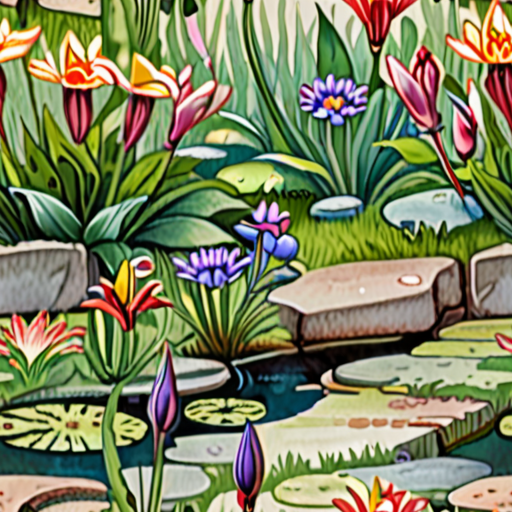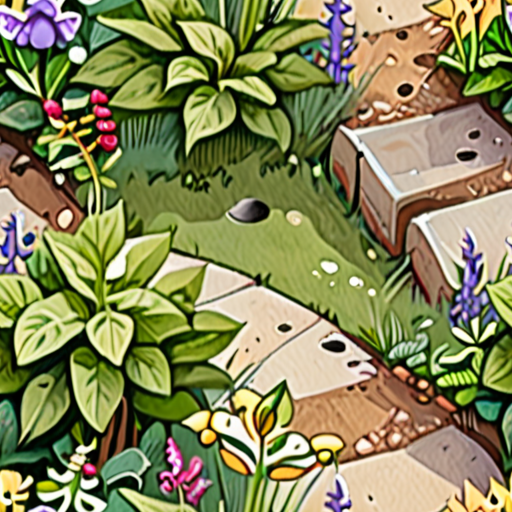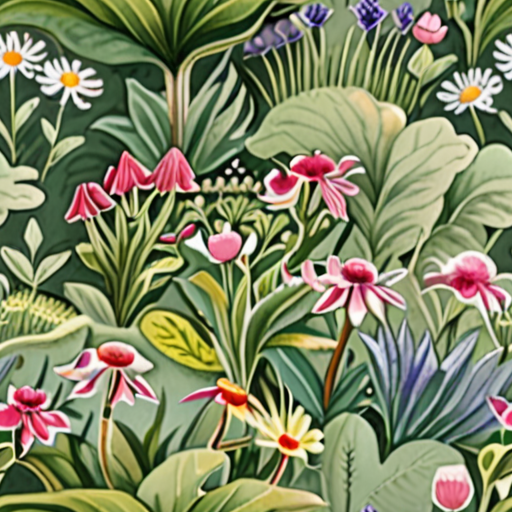As we continue to urbanize and pave over natural habitats, our gardens have become crucial sanctuaries for local wildlife and biodiversity. By designing a wildlife-friendly garden, you can create a haven for native species and contribute to the preservation of ecosystem balance in your own backyard. With a little creativity and planning, even the smallest spaces can become thriving oases that attract a variety of birds, bees, butterflies, and other beneficial insects.
Designing a Wildlife-Friendly Garden
To attract local species and preserve biodiversity in your backyard, consider the following steps:
-
Native Plants
Native plants are essential for attracting local wildlife, as they provide food, shelter, and breeding grounds for various species. Choose plants that are native to your region and suitable for your climate.
-
Water Sources
Install a birdbath, pond, or fountain to provide a source of water for birds, butterflies, and other animals. Change the water frequently to prevent mosquito breeding and maintain cleanliness.
-
Habitat Diversity
Create a diverse landscape by incorporating different types of vegetation, such as trees, shrubs, perennials, and annuals. This will provide a variety of habitats for local wildlife to inhabit.
-
Food Sources
Plant a variety of flowers, herbs, and vegetables that provide nectar, pollen, and seeds for pollinators and other animals. Consider adding a bird feeder or two to supplement their diet.
-
Shelter and Nesting Sites
Provide shelter and nesting sites for local wildlife by installing a bat house, bee hotel, or birdhouse. These structures will help protect animals from harsh weather conditions and predators.
-
Minimize Pesticides and Herbicides
Reduce or eliminate the use of pesticides and herbicides, which can harm local wildlife and contaminate soil and water. Instead, opt for organic gardening methods and natural pest control techniques.
-
Maintain a Diverse Ecosystem
Encourage a diverse ecosystem by leaving some areas of your garden untidy and allowing native plants to grow unchecked. This will provide a haven for beneficial insects, small mammals, and other animals.
-
Monitor and Learn
Observe the wildlife visiting your garden and learn about their habits, preferences, and needs. Adjust your garden design accordingly to create a welcoming environment for local species.
By implementing these strategies, you can create a thriving wildlife-friendly garden that attracts local species and preserves biodiversity in your backyard.
For more information on sustainable gardening practices and heirloom seed preservation, visit our website at https://oldseed.org/ .
Learn more about native plant species and their benefits at USDA.gov and discover the importance of habitat diversity at NationalWildlifeFederation.org .
Explore the world of organic gardening and natural pest control techniques at GardenOrganic.org.uk and get inspired by the beauty of wildlife-friendly gardens at WildlifeTrusts.org .
Wildlife-Friendly Gardening Ideas for Small Backyards
As a gardener who values sustainability and biodiversity, transforming your small backyard into a thriving wildlife oasis can be a rewarding experience.
- Create a pollinator-friendly garden by planting native flowers, shrubs, and trees that attract bees, butterflies, and hummingbirds.
- Incorporate a water feature, such as a birdbath or shallow dish, to provide a source of drinking water for birds and other wildlife.
- Add a rock pile or log pile to create habitat for reptiles, amphibians, and insects.
- Plant native grasses and wildflowers to provide food and shelter for small mammals and birds.
- Incorporate a compost bin to turn kitchen scraps into nutrient-rich soil for your garden.
- Leave some areas of your yard untidy, allowing leaves and branches to accumulate and provide habitat for beneficial insects and small animals.
- Install a birdhouse or two to provide a safe nesting spot for birds and other wildlife.
- Consider installing a bat house to attract these valuable insectivores.
- Plant a variety of plants that provide berries, seeds, and nuts for wildlife to eat.
- Leave some areas of your yard undisturbed, allowing native vegetation to grow and thrive.
Support Ecosystem Balance
To create a balanced ecosystem in your small backyard, consider the following:
- Plant a mix of native plants that provide food, shelter, and habitat for local wildlife.
- Avoid using pesticides and herbicides, which can harm beneficial insects and other wildlife.
- Use rain barrels or a cistern to collect and store rainwater for irrigation and other non-potable uses.
- Incorporate a green roof or living wall to provide habitat for plants and wildlife.
- Consider installing a pond or fountain to create a source of water for wildlife.
- Leave some areas of your yard untidy, allowing leaves and branches to accumulate and provide habitat for beneficial insects and small animals.
Natural Pest Control Methods
Instead of relying on chemical pesticides, try these natural pest control methods:
- Encourage beneficial insects, such as ladybugs and lacewings, by planting nectar-rich flowers.
- Use neem oil or diatomaceous earth to repel pests without harming beneficial insects.
- Plant marigolds or nasturtiums to repel aphids and whiteflies.
- Use physical barriers, such as fine mesh or row covers, to prevent pests from reaching your plants.
- Hand-pick pests, such as slugs and snails, to remove them from your garden.
Wildlife-Friendly Gardening Tips
Remember to follow these tips when creating a wildlife-friendly garden:
- Choose plants that are native to your region and suitable for your climate.
- Plant a variety of plants that provide food, shelter, and habitat for local wildlife.
- Avoid using invasive species, which can outcompete native plants and harm local ecosystems.
- Leave some areas of your yard untidy, allowing leaves and branches to accumulate and provide habitat for beneficial insects and small animals.
- Be patient and observe the changes in your garden over time.
Creating a Wildlifefriendly Garden: Key Elements to Consider
To maximize the effectiveness of your wildlifefriendly garden in supporting local ecosystems, there are several key elements to consider.
-
Incorporating Native Plants
Native plants are essential for attracting local wildlife, as they provide food, shelter, and breeding grounds for various species. Choose plants that are native to your region and suitable for your climate and soil type.
-
Providing Water Sources
Wildlife needs access to clean water for drinking and bathing. Install a birdbath, pond, or fountain to provide a reliable source of water. Change the water frequently to prevent mosquito breeding and maintain cleanliness.
-
Minimizing Pesticides
Pesticides can harm or kill wildlife, so it’s crucial to minimize their use in your garden. Instead, adopt integrated pest management techniques, such as hand-picking pests, using physical barriers, or introducing beneficial insects.
-
Creating Habitat Diversity
A diverse range of habitats attracts a wider variety of wildlife. Incorporate different types of vegetation, such as trees, shrubs, perennials, and annuals, to create a complex ecosystem.
-
Providing Food Sources
Offer a variety of food sources, including nectar-rich flowers, fruit-bearing plants, and insect-attracting plants. This will attract pollinators, birds, and other wildlife to your garden.
-
Creating a Safe Environment
Design your garden with safety in mind. Avoid using toxic chemicals, and instead opt for natural methods to control pests and diseases. Also, consider installing a fence or other barrier to protect your garden from predators.
-
Maintaining a Sustainable Ecosystem
Regularly monitor and maintain your garden’s ecosystem. Remove invasive species, prune plants to promote healthy growth, and adjust your watering schedule according to seasonal changes.
By incorporating these key elements, you’ll create a thriving wildlifefriendly garden that supports local ecosystems and attracts a diverse range of wildlife.
Additional Resources:
For more information on creating a wildlifefriendly garden, visit our wildlifefriendly gardening tips page or explore our native plant guide .
Recommended Reading:
Learn more about the importance of native plants in supporting local ecosystems by reading our article on native plants and local ecosystems .
Transform Your Ordinary Garden into a Thriving Wildlife-Friendly Oasis
To create a wildlife-friendly oasis that supports local biodiversity and provides a safe haven for native species, follow these essential steps:
-
Step 1: Assess and Prepare Your Garden
Start by evaluating your garden’s current state, including its size, soil type, and existing vegetation. Remove invasive plants, weeds, and debris, and consider consulting with a local nursery or gardening expert for advice on suitable native plant species.
-
Step 2: Choose Native Plant Species
Select plants that are native to your region and provide food, shelter, and habitat for local wildlife. Consider incorporating a mix of flowering plants, shrubs, trees, and grasses to attract a variety of species.
-
Step 3: Create a Water Source
Install a birdbath, pond, or shallow dish filled with fresh water to provide a drinking source for birds and other animals. Change the water regularly to prevent mosquito breeding and maintain cleanliness.
-
Step 4: Provide Food Sources
Incorporate bird feeders, suet cakes, and insect hotels to offer a diverse range of food sources for wildlife. Use organic and locally sourced materials whenever possible.
-
Step 5: Create a Safe Haven
Designate a quiet area of your garden as a safe haven for wildlife, free from predators and human disturbance. Incorporate dense vegetation, rocks, and logs to provide shelter and hiding spots.
-
Step 6: Maintain a Wildlife-Friendly Environment
Regularly monitor your garden’s condition, removing invasive species and debris, and adjusting your plant selection as needed. Consider implementing integrated pest management techniques to minimize chemical use.
-
Step 7: Educate and Engage
Share your knowledge with friends, family, and neighbors, encouraging them to create their own wildlife-friendly gardens. Participate in local conservation efforts and join online communities to stay informed about best practices and new developments in wildlife gardening.
By following these essential steps, you can transform your ordinary garden into a thriving wildlife-friendly oasis that supports local biodiversity and provides a safe haven for native species.
Creating a Thriving Sanctuary for Local Wildlife
As an avid gardener and advocate for sustainable living, I’m excited to share my expertise on transforming your outdoor space into a haven for local wildlife.
- Tip 1: Incorporate Native Plants
- Tip 2: Provide a Source of Water
- Tip 3: Create a Diverse Habitat
- Tip 4: Minimize Pesticide Use
- Tip 5: Offer Food Sources
- Tip 6: Maintain a Wildlife-Friendly Lawn
- Tip 7: Create a Wildlife Corridor
- Tip 8: Monitor and Learn
Native plants are essential for attracting local wildlife, as they provide food, shelter, and breeding grounds for various species. Research native plant species suitable for your region and incorporate them into your garden design.
A reliable source of water is crucial for wildlife survival. Install a birdbath, pond, or fountain to provide a constant water supply. Change the water regularly to prevent mosquito breeding and maintain cleanliness.
Diversify your garden by incorporating different textures, colors, and structures. This will attract a variety of wildlife, including insects, birds, and small mammals. Consider adding rocks, logs, and shrubs to create hiding spots and perches.
Pesticides can harm or kill local wildlife, so it’s essential to minimize their use. Instead, adopt integrated pest management techniques, such as companion planting, crop rotation, and biological control methods.
Provide food sources for wildlife by planting fruit-bearing trees, shrubs, or flowers. You can also offer suet feeders, bird tables, or insect hotels to supplement their diet.
A well-maintained lawn can support local wildlife. Leave some areas of your lawn unmanicured, allowing grasses and wildflowers to grow. This will provide habitat for beneficial insects and small animals.
A wildlife corridor connects isolated habitats, allowing animals to migrate and interact. Plant native vegetation along fences, walls, or boundaries to create a corridor for local wildlife.
Observe and learn from the wildlife visiting your garden. Note the types of species, their behavior, and any challenges they face. This will help you refine your garden design and make informed decisions to support local wildlife.
By implementing these tips, you’ll be well on your way to creating a thriving sanctuary for local wildlife. Remember to stay informed, adapt to changing conditions, and enjoy the rewards of sharing your garden with nature’s wonders.
Integrating Wildlifefriendly Gardening Principles into Your Existing Garden Plan
To create a thriving habitat for local species, consider incorporating the following wildlifefriendly gardening principles into your existing garden plan:
- Plant Native Species: Choose plants native to your region, which will attract local pollinators and provide food for wildlife.
- Create a Diverse Habitat: Incorporate a variety of plant species, including trees, shrubs, perennials, and annuals, to provide shelter and food for wildlife.
- Incorporate Water Features: Install a birdbath, pond, or fountain to provide water sources for wildlife and create a soothing atmosphere.
- Leave Some Areas Untidy: Resist the urge to tidy up every corner of your garden, leaving some areas untidy to provide hiding spots for small animals.
- Minimize Pesticide Use: Opt for organic gardening methods and minimize pesticide use to protect local wildlife.
- Provide Food Sources: Plant fruit-bearing trees, shrubs, and flowers to provide food for wildlife during different seasons.
- Install a Birdhouse or Nest Box: Provide a safe haven for birds and other small animals to nest and raise their young.
- Consider a Pollinator Garden: Create a dedicated pollinator garden featuring plants rich in nectar and pollen to support local bee populations.
Additional Tips for Creating a Thriving Wildlife Habitat
When designing your wildlifefriendly garden, remember to:
- Choose Plants with Different Blooming Times: Select plants that bloom at different times to provide a constant source of nectar and pollen for pollinators.
- Incorporate a Variety of Textures: Mix different textures, such as smooth leaves and rough bark, to provide visual interest and shelter for wildlife.
- Avoid Using Invasive Species: Steer clear of invasive plant species that can harm local ecosystems and outcompete native species.
- Consider a Rain Garden: Design a rain garden to collect and filter rainwater, reducing stormwater runoff and providing a habitat for aquatic life.
Conclusion
By incorporating these wildlifefriendly gardening principles into your existing garden plan, you can create a thriving habitat for local species and enjoy the many benefits of a biodiverse ecosystem.





0 Comments